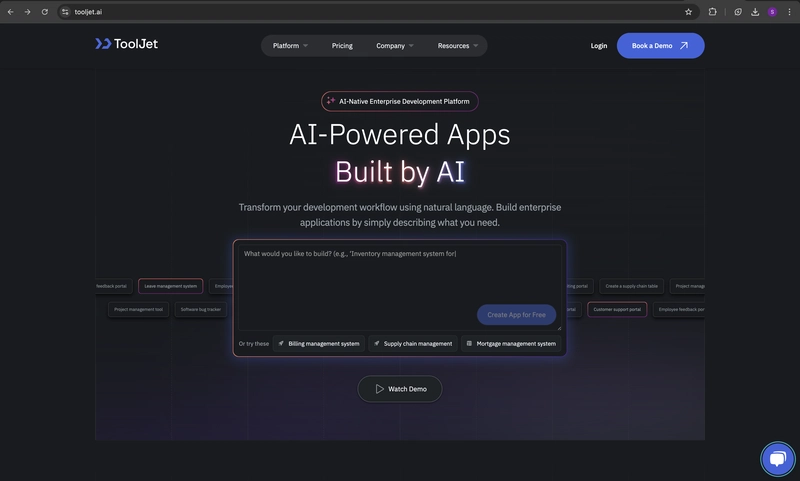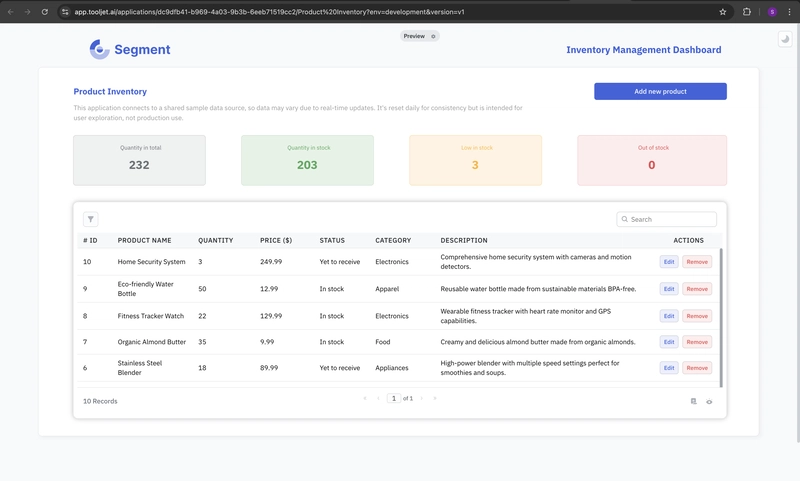ToolJet - AI Integrated Low-Code Platform
Recently, I got a chance to explore ToolJet.AI, an open-source low-code platform made for building and deploying custom internal tools. What makes it different is its built-in AI capabilities. Instead of dragging and dropping every element manually like in typical low-code platforms, here you just give it a prompt — a few words — and ToolJet starts creating the app structure for you. It uses AI to generate the UI and suggest layouts, which really speeds up the building process. What impressed me the most was how clean and usable the auto-generated screens were. It even picked a good color palette and gave me a working dark mode layout without me even asking for it. For my first try, I built a simple Stock Management Application that sends alerts when inventory gets low. ToolJet AI generated not just the UI but also created backend queries that I could directly edit and link with my database. I did all this using their free plan, and honestly, for anyone looking to build quick MVPs or internal apps, it’s more than enough. The free plan includes two builders, fifty end users, two apps, thirty AI credits per month, and community support via Slack. As you grow, you have the option to upgrade, but for small projects and testing ideas, the free tier is very practical. Here are some things I liked while working with ToolJet: AI-driven app building through simple prompts Drag-and-drop interface that feels quick and intuitive Backend queries that are editable without leaving the builder Auto-generated dark mode for the app UI Easy database and API integrations Open-source platform, so you can tweak the code if needed A very usable free plan to start building right away Of course, like any tool, it’s not perfect. ToolJet is still growing in popularity, and while the community is positive, it’s smaller compared to more established platforms. A few users (and even I) noticed that after major updates, minor bugs sometimes pop up, and the app can get a little heavy on the browser if you keep building non-stop for long hours. Another thing I felt missing was a built-in scheduler to automate repetitive tasks like sending stock alerts. If there’s a way to do it and I missed it, I’d love to know — otherwise, it would be a great feature to have in future updates. There are also a few things to keep in mind when using ToolJet. While it’s low-code, you’ll still need some basic tech understanding to make the most out of it, especially when dealing with custom integrations or database connections. If you’re planning to self-host ToolJet, managing the server setup and security requires solid knowledge too. Making deep customisations beyond the standard components usually needs developer-level skills. On G2, ToolJet holds a 4.8-star rating, although it’s based on fewer reviews compared to bigger players. Still, most users highlight how fast and simple the development process feels, which matches my experience too. Overall, I really liked working with ToolJet.AI. It feels like a powerful tool for developers and teams who want a flexible, cost-effective, open-source platform but also want to move fast with some AI help. If you’re into building internal tools, dashboards, or admin panels, and you like tweaking things when needed, ToolJet is definitely worth checking out.

Recently, I got a chance to explore ToolJet.AI, an open-source low-code platform made for building and deploying custom internal tools. What makes it different is its built-in AI capabilities. Instead of dragging and dropping every element manually like in typical low-code platforms, here you just give it a prompt — a few words — and ToolJet starts creating the app structure for you. It uses AI to generate the UI and suggest layouts, which really speeds up the building process. What impressed me the most was how clean and usable the auto-generated screens were. It even picked a good color palette and gave me a working dark mode layout without me even asking for it.

For my first try, I built a simple Stock Management Application that sends alerts when inventory gets low. ToolJet AI generated not just the UI but also created backend queries that I could directly edit and link with my database. I did all this using their free plan, and honestly, for anyone looking to build quick MVPs or internal apps, it’s more than enough. The free plan includes two builders, fifty end users, two apps, thirty AI credits per month, and community support via Slack. As you grow, you have the option to upgrade, but for small projects and testing ideas, the free tier is very practical.

Here are some things I liked while working with ToolJet:
- AI-driven app building through simple prompts
- Drag-and-drop interface that feels quick and intuitive
- Backend queries that are editable without leaving the builder
- Auto-generated dark mode for the app UI
- Easy database and API integrations
- Open-source platform, so you can tweak the code if needed
- A very usable free plan to start building right away
Of course, like any tool, it’s not perfect. ToolJet is still growing in popularity, and while the community is positive, it’s smaller compared to more established platforms. A few users (and even I) noticed that after major updates, minor bugs sometimes pop up, and the app can get a little heavy on the browser if you keep building non-stop for long hours. Another thing I felt missing was a built-in scheduler to automate repetitive tasks like sending stock alerts. If there’s a way to do it and I missed it, I’d love to know — otherwise, it would be a great feature to have in future updates.
There are also a few things to keep in mind when using ToolJet. While it’s low-code, you’ll still need some basic tech understanding to make the most out of it, especially when dealing with custom integrations or database connections. If you’re planning to self-host ToolJet, managing the server setup and security requires solid knowledge too. Making deep customisations beyond the standard components usually needs developer-level skills. On G2, ToolJet holds a 4.8-star rating, although it’s based on fewer reviews compared to bigger players. Still, most users highlight how fast and simple the development process feels, which matches my experience too.
Overall, I really liked working with ToolJet.AI. It feels like a powerful tool for developers and teams who want a flexible, cost-effective, open-source platform but also want to move fast with some AI help. If you’re into building internal tools, dashboards, or admin panels, and you like tweaking things when needed, ToolJet is definitely worth checking out.













































































































































































![[The AI Show Episode 144]: ChatGPT’s New Memory, Shopify CEO’s Leaked “AI First” Memo, Google Cloud Next Releases, o3 and o4-mini Coming Soon & Llama 4’s Rocky Launch](https://www.marketingaiinstitute.com/hubfs/ep%20144%20cover.png)
























































































































































![BPMN-procesmodellering [closed]](https://i.sstatic.net/l7l8q49F.png)


























































































-All-will-be-revealed-00-35-05.png?width=1920&height=1920&fit=bounds&quality=70&format=jpg&auto=webp#)
-All-will-be-revealed-00-17-36.png?width=1920&height=1920&fit=bounds&quality=70&format=jpg&auto=webp#)
-Jack-Black---Steve's-Lava-Chicken-(Official-Music-Video)-A-Minecraft-Movie-Soundtrack-WaterTower-00-00-32_lMoQ1fI.png?width=1920&height=1920&fit=bounds&quality=70&format=jpg&auto=webp#)






















































































































![What iPhone 17 model are you most excited to see? [Poll]](https://9to5mac.com/wp-content/uploads/sites/6/2025/04/iphone-17-pro-sky-blue.jpg?quality=82&strip=all&w=290&h=145&crop=1)

















![Hands-On With 'iPhone 17 Air' Dummy Reveals 'Scary Thin' Design [Video]](https://www.iclarified.com/images/news/97100/97100/97100-640.jpg)
![Mike Rockwell is Overhauling Siri's Leadership Team [Report]](https://www.iclarified.com/images/news/97096/97096/97096-640.jpg)
![Instagram Releases 'Edits' Video Creation App [Download]](https://www.iclarified.com/images/news/97097/97097/97097-640.jpg)
![Inside Netflix's Rebuild of the Amsterdam Apple Store for 'iHostage' [Video]](https://www.iclarified.com/images/news/97095/97095/97095-640.jpg)

































































































































